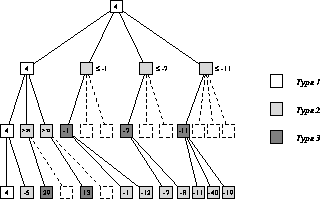




Next: Global Hash Table
Up: 14.3.3 Parallel Alpha-Beta Pruning
Previous: 14.3.3 Parallel Alpha-Beta Pruning
The standard source on mathematical analysis of the alpha-beta algorithm is
the paper by Knuth and Moore [Knuth:75a]. This paper gives a complete
analysis for perfectly ordered trees, and derives some results about randomly
ordered trees. We will concern ourselves here with perfectly ordered trees,
since real chess programs achieve almost-perfect ordering.

Figure: Pruning of a Perfectly Ordered Tree. The tree of
Figures 14.3 and 14.4 has
been extended another ply, and also the move ordering has been
rearranged so that the best move is always searched first. By
classifying the nodes into types as described in the text, the following
pattern emerges: All children of type one and three nodes are
searched, while only the first child of a type two node is searched.
In this context, perfect move-ordering means that in any position, we always
consider the best move first. Ordering of the rest of the moves does not
matter. Knuth and Moore show that in a perfectly ordered tree, the nodes
can be divided into three types, as illustrated by Figure 14.7.
As in previous figures, nodes are assumed to be generated and searched in
left-to-right order. The typing of the nodes is as follows. Type one nodes
are on the ``principal variation.'' The first child of a type one node is
type one and the rest of the children are type two. Children of type two
nodes are type three, and children of type three nodes are type two.
How much parallelism is available at each node? The pruning of the perfectly
ordered tree of Figure 14.7 offers a clue. By thinking through
the alpha-beta procedure, one notices the following pattern:
- All children of type one nodes are searched,
- Only the first child of a type two node is searched-the rest are
pruned; and
- All children of type three nodes must be searched.
This oscillating pattern between the node types is, of course, the reason for
distinguishing them as different types in the first place.
The implications of this for a parallel search are important. To efficiently
search a perfectly ordered tree in parallel, one should perform the following
algorithm.
- At type one nodes, the first child must be searched sequentially (in
order to initialize the alpha-beta bounds), then the rest can be searched in
parallel.
- At type two nodes, there is no parallelism since only one child will be
searched (time spent searching other children will be wasted).
- Type three nodes, on the other hand, are fully parallel and all the
children can be searched independently and simultaneously.
The key for parallel search of perfectly ordered chess trees, then, is to
stay sequential at type two nodes, and go parallel at type three nodes. In
the non-perfectly ordered case, the clean distinction between node types
breaks down, but is still approximately correct. In our program, the
hash table plays a role in deciding upon the node type. The following
strategy is used by a master processor when reaching a node of the chess tree:
Make an inquiry to the hash table regarding this position. If the
hash table suggests a move, search it first, sequentially. In this context,
``sequentially'' means that the master takes her slaves with her down this
line of play. This is to allow possible parallelism lower down in the tree.
If no move is suggested or the suggested move fails to cause an alpha-beta
cutoff, search the remaining moves in parallel. That is, farm the work out
to the slaves in a self-scheduled manner.
This parallel algorithm is intuitively reasonable and also reduces to the
correct strategy in the perfectly ordered case. In actual searches, we have
explicitly (on the nCUBE graphics monitor) observed the sharp classification
of nodes into type two and type three at alternate levels of the chess tree.





Next: Global Hash Table
Up: 14.3.3 Parallel Alpha-Beta Pruning
Previous: 14.3.3 Parallel Alpha-Beta Pruning
Guy Robinson
Wed Mar 1 10:19:35 EST 1995





